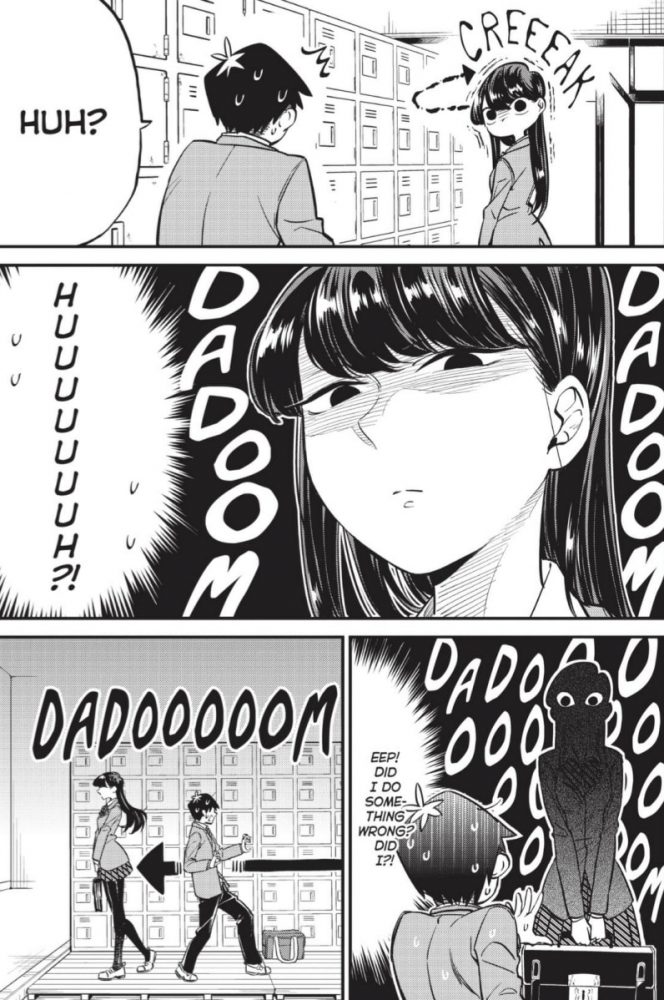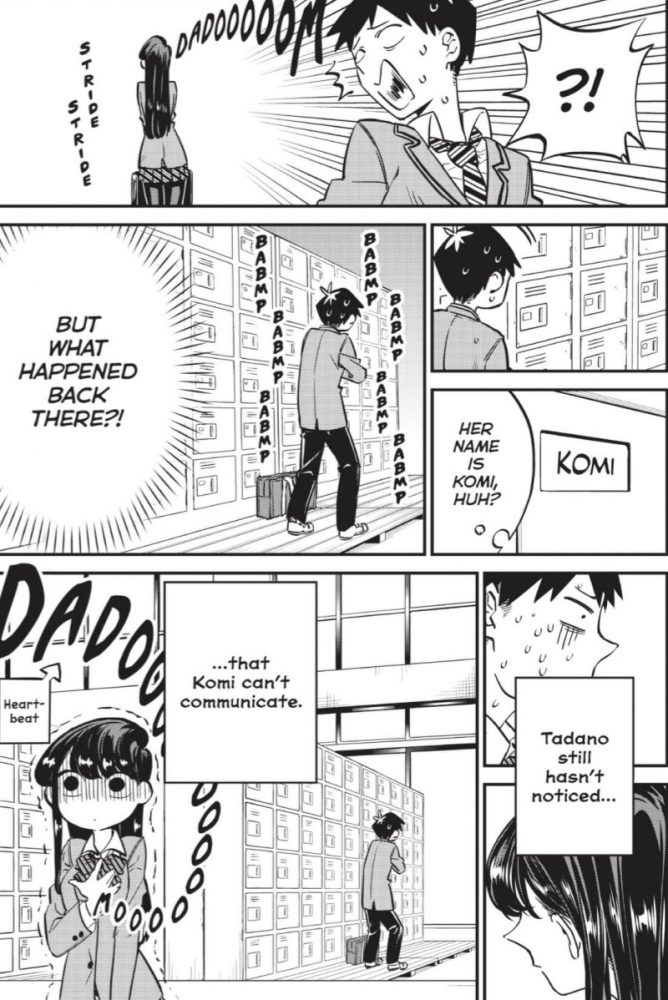The Komi Can’t Communicate manga is translated from the Japanese by John Werry
Tomohito Oda’s Komi Can’t Communicate manga (Komi-san wa Komyushou Desu) is a slice-of-life comedy that succeeds and fails in equal parts; propelled forward by a sweet premise that remains interesting, but its comedy moments are often jarring and forced.
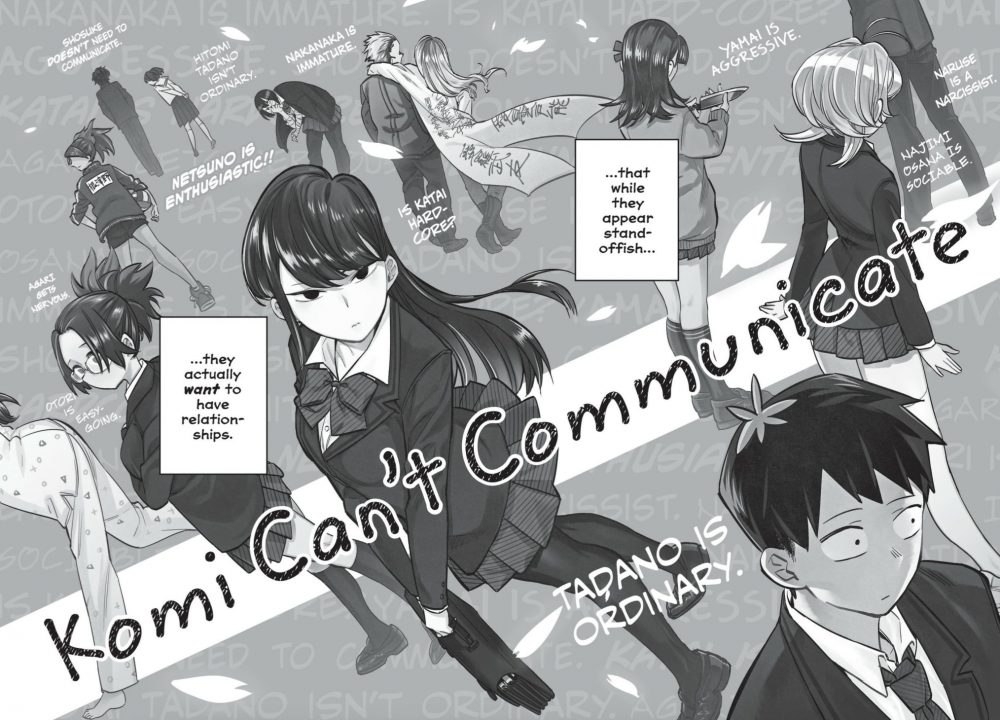
The titular Komi is a high school girl who is popular almost by default. She is immaculate, beautiful, and refined; she never speaks to anyone, and she reduces anyone who looks her way to a puddle with her piercing stare.
The way that Komi presents herself (not by choice, as we soon learn) leaves her beautiful and unapproachable, thus leaving her with this goddess-like aura; anyone who strays her way is unworthy of her attention.
Buy Volume 1 of the Komi Can’t Communicate manga here!
Where the Komi Can’t Communicate Manga Succeeds
Komi is a student at Itan Private High School, where Hitohito Tadano has just enrolled with the personal mission of being ordinary and simply fitting in. Like everyone else, Tadano is struck by Komi’s beauty and left paralysed by the looks she gives him.
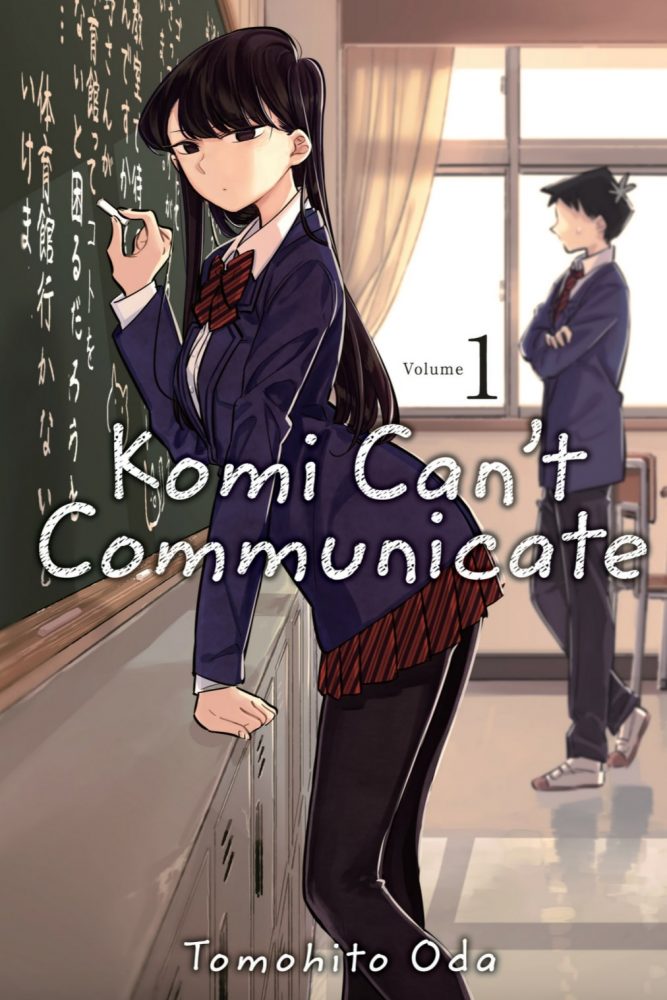
Unlike everyone else in their class, however, Tadano quickly figures out that Komi’s terrifying veneer of coldness is all a misunderstanding, one that she can’t put right because, as the title makes clear, Komi can’t communicate.
It turns out that Komi never wanted to be popular, off-putting, or unapproachable. She wants friends, but she is crippled by a high level social anxiety that renders her mute.
The cold stare that Komi sends everyone is actually a look of desperation and fear, one that every other student misinterprets, leading to them either fearing or admiring her. Komi is “popular” but that’s useless to her. She wants friends and company, but Komi can’t communicate.
Early in the Komi Can’t Communicate manga, Tadano figures out how to communicate with Komi: via written messages, first on the blackboard and then in paper notes and text messages.
Tadano has vowed to help Komi with her communication skills; her ultimate goal being to make one hundred friends. Tadano becomes friend number one, and from here we have a formula for a charming slice-of-life comedy manga.
The setup and story of the Komi Can’t Communicate manga is a really solid one. It gives us a charming pair of characters to begin our story: a girl and a boy with no romantic chemistry who have a sort of quest to undertake together.
It also gives us a very relatable theme for younger readers to latch onto. Communication issues, loneliness, and misunderstanding are all very common stresses amongst teenagers, and many will surely find a friend in Komi.
This setup leaves so much room for growth, as Komi will meet and befriend many interesting and eccentric characters, all of which we will get to enjoy in different ways. It’s a perfect slice-of-life manga setup.
The art of the Komi Can’t Communicate manga also helps us to fall in love with these characters, especially the titular Komi. The way she is drawn — sometimes as a tall and foreboding figure, and other times as a Nezuko-like chibi thing with wide eyes — really sells us on how she is perceived by strangers and her real vulnerabilities.
Tadano is also a simple and likeable character: he’s a sweet dogooder, not overly complex or interesting but the perfect mentor/sidekick for a lead character like Komi. She barely speaks, and the speaking he does is simple and practical.
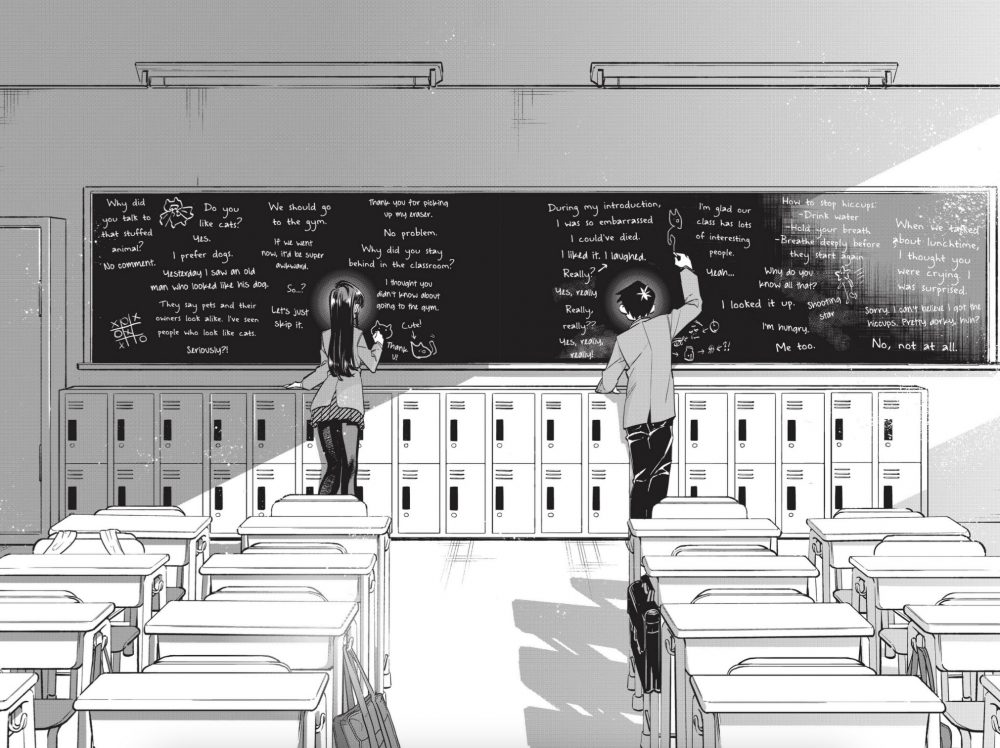
This leaves plenty of room for the eccentric comedy aspect of the Komi Can’t Communicate manga to be explored and filled by secondary characters we come to meet along the way.
It’s exactly here, however, where the Komi Can’t Communicate manga slips up. As a slice-of-life manga, it’s relatable and sweet. As a comedy, it’s awkward and full of missteps.
Buy the Komi Can’t Communicate manga boxset here!
Where the Komi Can’t Communicate Manga Fails
Comedy is subjective; everyone knows that. For many of us, comedy most obviously fails to impress when it’s offensive or cruel; when it punches down pointlessly for some cheap laughs that only assholes will find funny.
That’s not the case with the Komi Can’t Communicate manga (except for one possible exception which I’ll come to in a moment). For the most part, this comedy manga fails at its comedy simply because its goofy jokes are tired or downright confusing.
Before we dig into that, I should make it clear that the English translation for the Komi Can’t Communicate manga was done by John Werry, and he’s done a great job throughout. So I won’t blame the awkward comedy on crooked translation at all.
The style of comedy in this slice-of-life manga is a blend of misunderstanding, goofy slapstick, and visual gags (the kind where characters react explosively to something unexpected or strange).
The jokes which land best are the ones that involve Komi herself, as she stares someone down or reveals her cuter side, all of which is delivered wordlessly and through Tomohito Oda’s art alone.
The jokes which don’t land are the ones that aren’t immediately clear; ones that are surreal or strange and take multiple reads to even follow. These jokes feel very much like failed imitations of Nichijou (a flawless slice-of-life comedy manga).
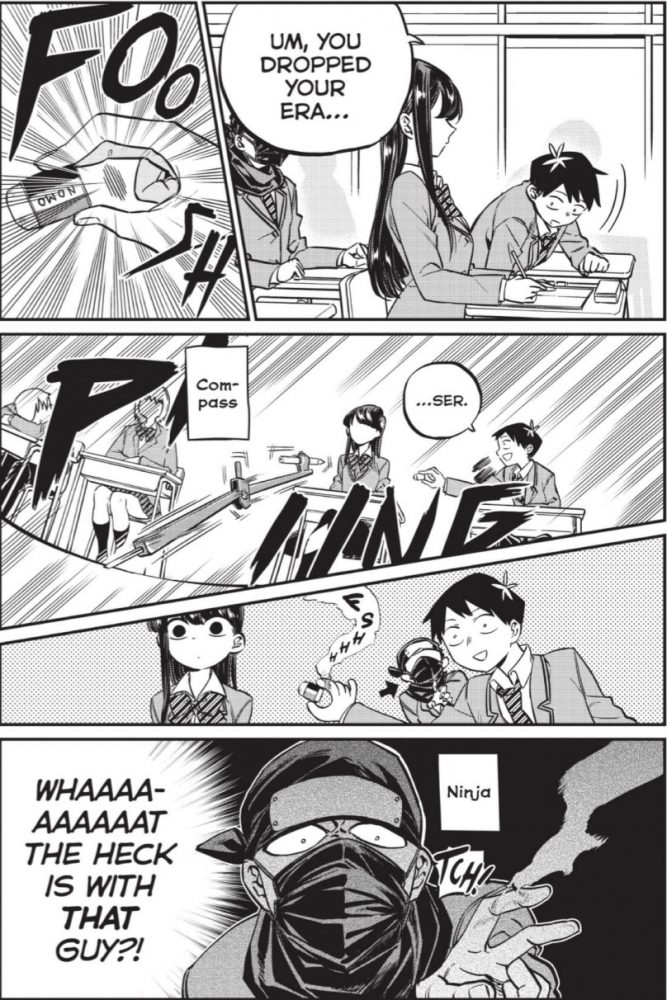
The best example of this Nichijou-esque humour is right here, in Chapter 3: Tadano, sitting at his desk, bends down to pick up Komi’s fallen eraser but is almost stabbed by a rogue flying compass, tossed by an anonymous boy dressed like a ninja.
This joke is odd, and that’s part of the comedy. It’s certainly not funny, but it’s also made worse by Oda’s curious choice of formatting, where Tadano/the narrator’s interior thoughts are presented as: “compass” and “ninja”. Something about the inclusion and placement of these text boxes makes the already jarring joke even more hopeless.
Obviously, this is just one small gag in a large manga, but jokes like this one abound and they never land, in my opinion. They do, however, do the job of keeping this manga lighthearted and us, as readers, on our toes.
I mentioned before that there is a joke that may or may not be construed as offensive. The joke involves the gender identity of Komi’s second friend, Najimi Osana.

Najimi’s quirk is that they’re friends with everyone in school; they’re the most friendly and sociable person that Itan Private High School has. When we first meet them, Tadano remembers them from junior high, and is sure that Najima is/was a boy.
When we meet Najimi, however, they’re wearing a skirt. Tadano presses them about their gender and Najima laughs it off.
Their gender presentation is certainly feminine. In fact, in a later chapter, Najimi is hit on by two lads and deflects by explaining that they’re a boy. So, calling them non-binary doesn’t seem to fit (not that you have to; perhaps gender-non-conforming is enough).
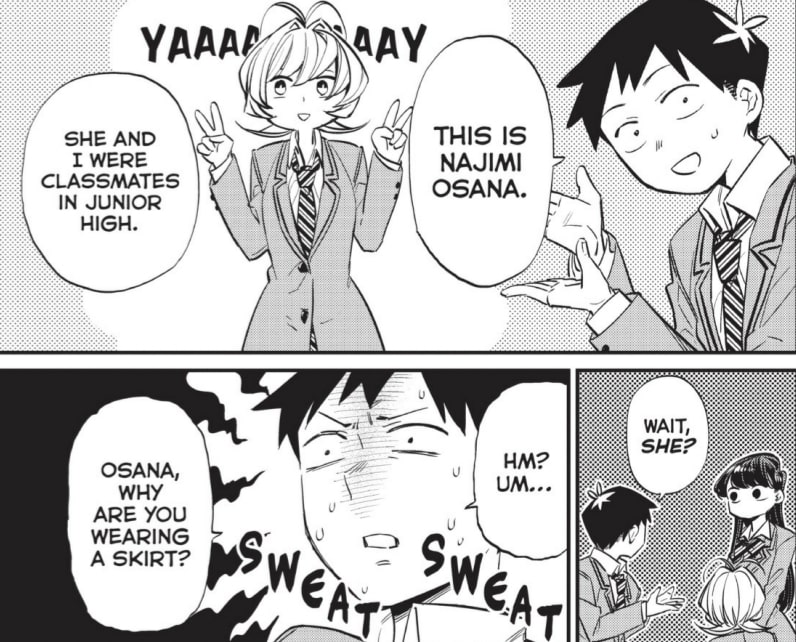
Speaking as a non-binary reader, even I can’t figure out where this running gender jokes involving Najimi lands, and how I should feel about it. Najima themselve comes across as very progressive and inspiring, but the way in which other characters (most notably Tadano) react makes the joke feel more fuzzy.
Ultimately, how you feel about the humour of the Komi Can’t Communicate manga will be up to you. As I said, comedy is subjective. I love camp, surrealism, and simple goofs, but even I failed to find most of the jokes in this comedy manga funny.
All of that said, Komi Can’t Communicate remains a sweet, lighthearted manga with a likeable protagonist, a diverse and caricatured cast of supporting characters, and a very relatable moral message.

